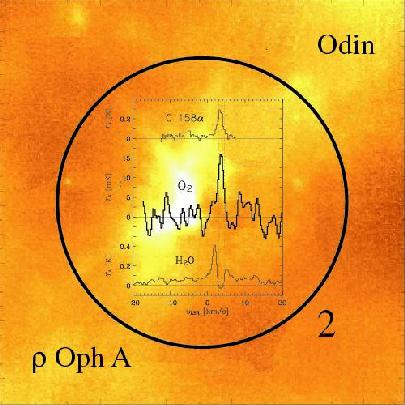Oxygen is the most abundant element in the Universe after hydrogen and helium. It is twice as much abundant as the next element, carbon. Therefore, it is expected that species like O (atomic oxygen), OH (hydroxyl radical), H2O (water) and O2 (di-oxygen or molecular oxygen) be abundant in the interstellar gas. If the first 3 have been indeed detected in the interstellar medium, it was not the case for the O2 molecule until today. However, its next of kin, CO (carbon monoxyde) is routinely observed and is even used as a molecular hydrogen (H2) tracer, H2 being invisible at low temperature. Why ? Our atmosphere being full of molecular oxygen, the ground-based telescopes are totally blind in the frequency ranges of the different O2 transitions. Several possible strategies have been used to circumvent this problem (such as to observe rare isotopologues like O18O which do not saturate the receivers, to observe far remote extragalactic sources to take advantage of their redshifting away from the blocking atmospheric lines, to use planes or balloons, etc.). However, the best is to launch a satellite in order to be above the atmosphere to observe the O2 molecule.

This is what two teams have successively achieved. The first, american, has launched a small satellite, SWAS, which focused on measuring water and molecular oxygen in space, followed by a second, twice as much bigger, Odin, constructed by 4 countries (Sweden, France, Finland and Canada), the goals of which where globally the same but with extended capabilities. In particular, Odin is equipped with a receiver dedicated to the search of the ground transition of O2 (a priori the most intense line in regions colder than 100 K). Odin just comes up with success, detecting this line in the direction of a large molecular cloud nearby, Rho Oph A in the Serpens constellation.

Searches for the O2 molecule started in the beginning of the ’80s. It quickly appeared that the quest would not be that easy because the molecule, supposedly very abundant did not show up despite the continuous improvement of the receiver sensitivity. There have been several false alarms. This first detection suggests that the abundance of O2 is 1000 times lower than originally expected but it is only a rough estimate. The Odin satellite angular resolution being relatively low (roughly ten times as bad as that of human eye), we don’t know exactly where is situated the source of emission in the observed spot. Higher angular resolution observations will be done with Herschel, the next satellite which should be launched in space by the European Agency ESA in 2008.
Reference B. Larsson, R. Liseau, L. Pagani, P. Bergman, P. Bernath, N. Biver, J.H. Black, R.S. Booth, V. Buat, J. Crovisier, C.L. Curry, M. Dahlgren, P.J. Encrenaz, E. Falgarone, P.A. Feldman, M. Fich, H.G. Flore’n, M. Fredrixon, U. Frisk, G.F. Gahm, M. Gerin, M. Hagstroem, J. Harju, T. Hasegawa, Aa. Hjalmarson, C. Horellou, L.E.B. Johansson, K. Justtanont, A. Klotz, E. Kyroelae, S. Kwok, A. Lecacheux, T. Liljestroem, E.J. Llewellyn, S. Lundin, G. Me’gie, G.F. Mitchell, D. Murtagh, L.H. Nordh, L.-Aa. Nyman, M. Olberg, A.O.H. Olofsson, G. Olofsson, H. Olofsson, G. Persson, R. Plume, H. Rickman, I. Ristorcelli, G. Rydbeck, Aa. Sandqvist, F.v. Sche’ele, G. Serra, S. Torchinsky, N.F. Tothill, K. Volk, T. Wiklind, C.D. Wilson, A. Winnberg, G. Witt Molecular oxygen in the rho Ophiuchi cloud Astronomy & Astrophysics, in press
